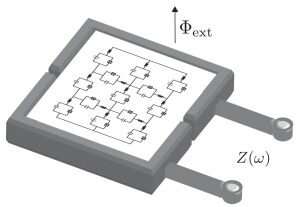New Josephson junction study links quantum theory to experiment

The Josephson junction is one of the most important elements in turning quantum phenomena into usable technology.
A new RMIT study establishes a theoretical framework for new optical experimentation on these key devices, with implications for future fundamental quantum research and applications such as quantum computing.
Josephson junction studies
Josephson junctions can be formed by two superconducting plates, separated by a very-thin insulating layer, with electronic charge traveling from one plate to the other via quantum tunnelling, and is an important bridge between quantum mechanics at the micro-scale and practical technologies at the macroscale.
Applications include existing devices such as magnetic field detectors (called SQUIDs), and emerging technologies such as quantum computers.
Josephson junctions are also of interest from a fundamental perspective, used as physical realizations of theoretical models to study phase transitions and topological excitations.
The fabrication technology for these systems is now sufficiently advanced that the parameters governing the physics of interest can be fine-tuned with a high degree of precision.
Shifting experimental focus from electronic transport to microwaves
Studies of Josephson junction devices to date have typically focused on electronic transport measurements: experimenters attach metallic leads to the device, apply a voltage, and measure the resulting output current.
However, the presence of those electrical connections inevitably introduces an additional source of noise, which destroys many of the quantum effects the experimenters wish to study.
Mitigating this charge noise, and minimizing the interaction between the quantum device and the noisy outside world, are major challenges to the development of practical quantum technologies.
Recent experiments (Hiroshi Nakamura, Riken, Japan) have circumvented the problem of noisy leads by putting their device in a 3-D cavity where the system can be probed via microwaves. This reduces the contact between the device and the environment, allowing for much cleaner and more coherent study.
The experiment being performed is no longer electronic transport, but spectroscopy.
To maximize the success of this radical new technique, new approaches are required to describe the experiments theoretically.
New theoretical framework: vortices connect theory to experiment
The new RMIT study establishes a theoretical framework for modeling these spectroscopic, microwave experiments on Josephson junctions.
The study focuses on vortices created by magnetic fields threading through any closed loops in the circuit.
Incoming microwaves can drive transitions between different vortex states, which leads to a measurable response.
The theory developed at RMIT provides a general framework for constructing a description of arbitrary planar circuits and extracting measurable quantities from the underlying theory.
"This work connects theory to experiment," says lead author, FLEET Ph.D. student Sam Wilkinson. "It connects theoretical formulations of superconducting networks to microwave spectroscopy experiments, and should open up new avenues for designing and describing coherent quantum systems."
Because Josephson junction arrays can be designed and manipulated with a large degree of control, they made ideal model systems for studying complicated many-body physics. These systems tend to exhibit very long-ranged interactions and very strong coupling—two features that typically make systems difficult to study theoretically.
"We are hoping that our Josephson junction studies will help with other complex studies too," says group leader Prof Jared Cole. "Hopefully, by developing tools to understand these controllable systems, we will learn lessons that can be applied to other highly-interacting systems—systems where we typically have less experimental control."
More information: Samuel A. Wilkinson et al. Linear response theory of Josephson junction arrays in a microwave cavity, Physical Review B (2019). DOI: 10.1103/PhysRevB.99.134502
Journal information: Physical Review B
Provided by FLEET




















